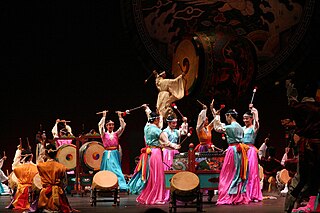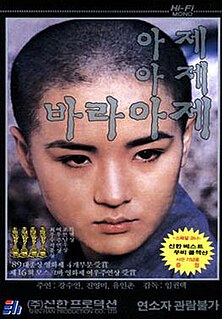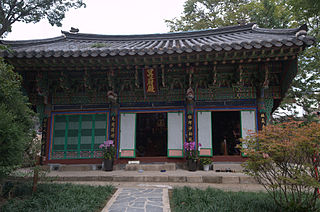Gihwa, also known as Hamheo Teuktong was a Buddhist monk of Korean Seon and leading Buddhist figure during the late Goryeo to early Joseon eras. He was originally a Confucian scholar of high reputation, but converted to Buddhism at the age of 21 upon the death of a close friend. He wandered among the Korean mountain monasteries, until he had the fortune of becoming the disciple of the last Korean national teacher, Muhak.

Obon (お盆) or just Bon (盆) is a Japanese Buddhist custom to honor the spirits of one's ancestors. This Buddhist-Confucian custom has evolved into a family reunion holiday during which people return to ancestral family places and visit and clean their ancestors' graves when the spirits of ancestors are supposed to revisit the household altars. It has been celebrated in Japan for more than 500 years and traditionally includes a dance, known as Bon Odori.

The Chinese Buddhist canon refers to the total body of Buddhist literature deemed canonical in Chinese, Japanese, Korean and Vietnamese Buddhism. The traditional term for the canon ."

Cheonan, also spelled Ch'ŏnan, is a city in South Chungcheong, South Korea.

Hongseong (Hongseong-gun) is a county in South Korea, and the capital of South Chungcheong Province. The current governor is Kim Seok-hwan. The original name of this city is Hongju.

Dance in Korea began with shamanistic early rituals five thousand years ago and now ranges from folk dance to newly created and adopted contemporary dance.

The Asian Indoor Games were a multi-sport event that was contested every two years among athletes representing countries from Asia. The games were regulated by the Olympic Council of Asia. The first games were held in 2005 in Bangkok, Thailand.

Kang Soo-youn is a South Korean actress. She was born in Seoul, South Korea and was one of the best known and internationally acclaimed stars from South Korea from the mid-1980s to the end of the 1990s.

The roots of Buddhism in Poland can be found in the early 20th century in the nation's connections to the origin countries of the religion, like Vietnam, China, Japan, and Korea. After World War II, primarily expatriate Poles joined various Buddhist groups and organizations. Since the breakdown of the Eastern Bloc, which promoted an antireligious campaign, Buddhism has been able to develop further in the more tolerant atmosphere.

Come Come Come Upward is a 1989 South Korean film directed by Im Kwon-taek.

Nabichum is a Korean Buddhist dance (Jakbeop) for ritual service. The dance is named after its choreography and costume which resemble the appearance of butterfly. Some people regard nabichum as the most representative and important dance among Korean Buddhist dances. Dancers wear jangsam and white gokkal.
Narowal is a tehsil located in Narowal District, Punjab, Pakistan. It is administratively subdivided into 39 Union Councils, four of which form the tehsil capital Narowal.
Gyeongguksa is a Buddhist temple of the Jogye Order in Seoul, South Korea. Founded in 1325 it is located in 753 Jeongneung-dong, in the Seongbuk-gu area of the city.

Heungcheonsa is a Buddhist temple of the Jogye Order in Seoul, South Korea. It is located at 592 Donam-dong, in the Seongbuk-gu area of the city.

The Soul of Buddha is a 1918 American silent romance film directed by J. Gordon Edwards and starring Theda Bara, who also wrote the film's story. The film was produced by Fox Film Corporation and shot at the Fox Studio in Fort Lee, New Jersey.
Pyeongtaek nongak is a nongak or Korean farmer's music which has been performed and handed down in the Pyeongtaek region of Gyeonggi Province.

Sŏgwang-sa is a Korean Buddhist temple located in Sŏlbong-ri in Kosan County, Kangwon Province, North Korea. Once one of Korea's largest Buddhist temples, the complex was mostly destroyed by US bombing in 1951, and today it lies in ruins; however, it is slated to be reconstructed in coming years. It is listed as National Treasure #94
Bara Gewog is a former gewog of Samtse District, Bhutan. The gewog has an area of 186 square kilometres and contains 474 households. Bara Gewog comprises part of Sipsu Dungkhag (sub-district), together with Tendu, Biru, Lehereni, and Sipsu Gewog Gewogs.
Bara Bará Bere Berê is a popular Brazilian song in Portuguese language. The refrain is a Bahian protect song created by Dorgival Dantas, with folk dance, rhythmic samba and merengue influences. The song has been subject to various interpretations by a great number of Brazilian artists, and various lyrics and additional music added to the original Dorgival Dantas version.
This page is based on this
Wikipedia article Text is available under the
CC BY-SA 4.0 license; additional terms may apply.
Images, videos and audio are available under their respective licenses.












